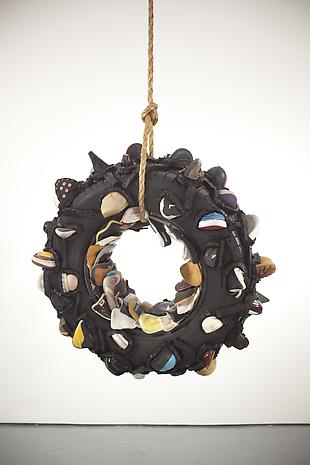At first glance of this work by Belkis Ayon, I was actually fairly confused, and maybe a little scared. All the pictures at first glance seemed very spooky, like something out of a child’s nightmares. Also at first glance, I noticed that there was some sort of a fish in every single piece of art, including this one. Looking at it from first glance, this portrait seemed to reflect those that were well off in life, at least stereotypically. The stereotypical rich family standing beside a campfire with a big chair and a footrest was what this artwork looked like originally, but after studying it, it showed something completely different.
After going back and analyzing this piece of artwork, I noticed things that I didn’t notice before. For example, there are many different religious connotations that can be taken from this artwork. The person in the chair is wearing a cross, along with the serpent along the shoulders of the person standing on the chair, possibly representing the devil in the Bible story of Adam and Eve. Looking closer, I can possibly argue a more political and racial side to this artwork. Going back to the original idea of this artwork representing a rich individual, a political way that this could go would be that it is normally Caucasian people that are found to be the ones well off in life, while everyone else struggles to make ends meet. The artist could have been going for a reversal of that typical scenario, and bringing attention to the fact that others should also be able to be well off as well. The individual shaded in dark could represent someone of color, while the individual shaded in white could represent a person of Caucasian descent. The person sitting in the chair has the posture of someone that is in charge and in control, so it could represent the person that is well off, while the person standing could almost be taken as a person who is inferior.
Another way that this piece of artwork could be taken is deeper into the religious aspect, but not in the way that I originally thought. Instead of a political and racial standpoint, the artist could be making a religious standpoint about Christianity. The person in the chair is completely shaded in black and for most people, black is usually a bad sign. The other person is shaded in white, which is usually taken as a sign of purity, but the only problem with this is the serpent lying around their shoulders. In accordance with the Bible, a serpent is a sign of the devil, so the deeper meaning to this artwork could be that not everyone appears as they seem. While someone may seem like a good person and do good things, they may have the worst intentions towards others, while the other individual who is maybe seen as a bad person or an outcast has just as good a heart and intentions as a saint. Whatever the political, racial or religious point that the artist is trying to make, it is done very subtly, and requires the observer to go past just the obvious of what is going on. This seems to speak volumes about a lot of issues without even saying a word, and this is a prime example of what art can express that physical action cannot.















